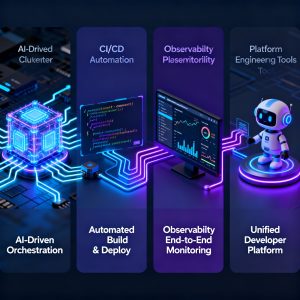Microsoft’s introduction of the Agent Framework marks a pivotal advancement in enterprise AI development—ushering in a unified, developer-focused environment for building, orchestrating, and managing intelligent agents. This innovation extends the company’s Agentic DevOps vision introduced at Build 2025, linking AI agents seamlessly across Azure, Copilot Studio, Fabric, and Semantic Kernel to transform every phase of the software lifecycle.
Microsoft’s New Foundation for Agentic Systems
The Microsoft Agent Framework, now in public preview, provides a unified SDK and runtime that simplifies the orchestration of multi-agent systems. It merges Microsoft Research’s AutoGen technology with the enterprise-ready foundations of Semantic Kernel, forming a single commercial-grade platform to help enterprises transition from pilot AI assistants to production-ready agentic systems.
Developers can now:
- Experiment locally and deploy to Azure AI Foundry with built-in observability and compliance.
- Integrate external APIs using OpenAPI, and enable dynamic tool orchestration through the Model Context Protocol (MCP).
- Leverage Agent-to-Agent (A2A) communication to coordinate agents across runtimes and cloud services.
- Adopt multi-agent workflows that automate end-to-end processes—spanning coding, deployment, and operations.
This unified approach makes it easier for teams to deploy agents that reason, act, and collaborate autonomously, delivering consistent results across development, testing, and production.
A Step Forward in Microsoft’s Agentic DevOps Strategy
At Build 2025, Microsoft unveiled its Agentic DevOps initiative, centered on embedding intelligent agents across the full software development lifecycle (SDLC). The Agent Framework now operationalizes that vision—connecting AI systems that can assist in everything from code creation and test automation to deployment optimization and monitoring.
This approach signifies a shift from assistive copilots to integrated, policy-governed agent ecosystems. Through Azure AI Foundry and Copilot Studio, enterprises can now construct intelligent, composable software pipelines that combine automation with accountability.
Key Features Driving Enterprise Adoption
The Agent Framework introduces several enterprise-grade capabilities designed to ensure safe, scalable agent adoption:
- Unified Development Model: Standardizes how agents are built and deployed across Azure, Copilot Studio, and Semantic Kernel.
- Governance and Security: Built-in authentication and access control through Microsoft Entra ID deliver enterprise-grade identity management.
- Policy Enforcement: Supports auditability with permission-bound actions and compliance-ready configurations—critical for regulated industries.
- Observability Standards: OpenTelemetry integration enables tracing, debugging, and analytics across agent systems.
- Integration Flexibility: Developers can connect agents with existing DevOps tools and CI/CD pipelines for seamless workflow automation.
According to Microsoft, more than 70,000 organizations already leverage Azure AI Foundry solutions. Enterprises like KPMG, TCS, Citrix, and Elastic are implementing the Agent Framework to streamline operations, enhance reliability, and accelerate AI-driven transformation.
From Coding to Contextual Collaboration
This framework signals a broader move from isolated coding assistants to what Microsoft defines as the Agentic Development Lifecycle (ADLC)—a model in which intelligent agents contribute across every stage of delivery.
Agents can now test software autonomously, analyze telemetry data, optimize resource utilization, detect security issues, and even remediate them proactively. By connecting Azure AI Foundry, Fabric’s contextual data layer, and Copilot Studio workflows, Microsoft is engineering a tightly integrated development environment that merges productivity with compliance and observability.
As highlighted by Futurum Research, organizations adopting these frameworks are experiencing:
- Improved developer productivity through automation.
- Accelerated testing and integration cycles.
- The emergence of new roles centered around AI-driven software delivery and governance.
Competitive Context and Enterprise Outlook
Microsoft’s strategic advantage lies in its breadth—spanning cloud infrastructure, developer ecosystems, and productivity tooling. However, competition remains fierce, with AWS, Google, IBM, and OpenAI expanding their own frameworks for agent development.
Analysts predict that interoperability will define success in this emerging ecosystem. Frameworks that champion open protocols such as MCP and cross-platform collaboration are likely to dominate enterprise adoption. Microsoft’s commitment to open standards positions the Agent Framework as a backbone for cross-vendor integration rather than a closed ecosystem.
Strategic Recommendations
For technology vendors:
- Focus on interoperability to support open protocols and cross-ecosystem agent collaboration.
- Enhance developer experience with standardized SDKs, templates, and community resources.
- Invest in governance features to foster long-term enterprise confidence in agentic systems.
For enterprises:
- Shift focus from generating code faster to achieving measurable improvements in delivery, reliability, and operations.
- Implement human-in-the-loop controls to mitigate governance and automation risks.
- Experiment with AI in CI/CD, observability, and auto-remediation to gain early competitive advantages.
What Comes Next
Microsoft’s Agent Framework continues to mature rapidly, with General Availability (GA) expected in 2026. Early adoption indicators to watch include:
- Enterprise expansion of agent-driven CI/CD and observability.
- Integration depth with Copilot Studio, Azure OpenAI Service, and Fabric.
- The growth of agent-based self-healing infrastructure solutions across industries.
As Microsoft’s framework evolves into full production readiness, it has the potential to become the cornerstone of enterprise AI orchestration—bridging software automation, governance, and continuous innovation.
Read more such articles from our Newsletter here.



